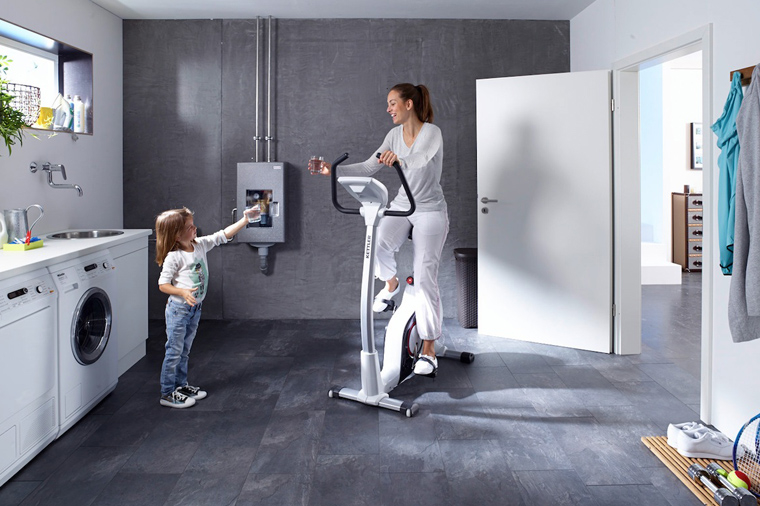Plumbing in buildings combines numerous components – the drinking water system and the heating system, for instance. Devices such as system separators are inserted to prevent hazardous liquids such as heating water from entering the drinking water system at these “interfaces”. These safety devices are a significant contribution to the protection of drinking water hygiene. The manufacturers in the Blue Responsibility sustainability initiative know which system is required in which location.
Numerous standards in Germany ensure that our taps deliver hygienic, clean drinking water. But from the building connection onwards, building owners are independently responsible for the proper operation of the drinking water system. In addition to stagnation, backpressure, backflow and return suction are real hazards for drinking water hygiene. “Backpressure is created when different pressure levels are present in different systems. This can allow contaminated water to enter back into the drinking water system. A simple example are pressure washers which can push back non-potable water containing cleaning agents,” Ulrich Petzolt from Kemper explains. Backflow and return suction are also caused by differences in pressure. A variety of malfunctions in the supply system can cause negative pressure in the drinking water system and therefore a return suction effect, e.g. from a device or through the heating system. If these systems are not separated by a safety device, the drinking water can be contaminated with polluting, sometimes even toxic substances.
The right protection for any liquid category
The regulations for lasting protection of drinking water quality are set down in EN 1717 “Protection against pollution of potable water in water installations and general requirements of devices to prevent pollution by backflow”, among other regulations. “This standard divides liquids into different categories. The higher the category, the greater the hazard this liquid poses for drinking water and people,” Marcel Wirtz from Syr says. A category 1 liquid corresponds to the drinking water which is taken from a tap directly from the drinking water system. No protection is required here. While category 2 liquids do not pose a health hazard, the drinking water may be altered in taste, smell, colour or temperature. At least a type EA backflow preventer has to be used in this case. “Liquids from category 3 onwards pose a slight health hazard from one or more toxic substances, for example household bath water or heating water without inhibitors, so that at least a system separator of type CA has to be used,” Volker Galonske from Honeywell explains. Liquids which pose a significantly greater hazard to human health through toxic, radioactive, mutagenic or carcinogenic substances are classified as category 4 and have to be protected with a system separator of type BA. The various system separators differ in their designs with regard to the housing and the differential pressure control unit. “The system separators of types CA and BA have different separation characteristics. The intermediate pressure chamber can only be checked on the type BA, which means the pressure difference of 140 mbar – where the safety valve has to separate at the latest – can be measured precisely,” Ulrich Petzolt explains.
The highest safety requirements are in place for safeguarding category 5 liquids. These may contain microbial or viral pathogens and are a substantial hazard to human health. “These scenarios can, for example, be found in livestock breeding or when using well water or rain water,” Marcel Wirtz says. Normal system separators are not sufficient for category 5. Complete safety separator stations, as offered by Honeywell or Syr, are used in these cases. “Our separator station is fully automatic and consists of a master tank with a free outlet for hygienic separation of drinking water and category 5 liquids as well as a single or double pump unit,” Volker Galonske explains.
Professional installation and maintenance of system separators
As in all drinking water systems, the generally accepted state of the art also applies to the installation of system separators. This concerns the place of installation, among other things. “The system separators have to be installed in such a way that they cannot be flooded. Also, rooms where chemicals are stored have to be avoided because they could lead to problems in the system,” Galonske continues. Additionally, sufficient space for safety devices has to be planned. These always consist of several fittings required by EN 1717 which – together with the safety fitting – constitute the safety device. “The BA safety fitting, for example, consists of an intake-side shut-off device, a stone trap or sieve, the actual BA system separator and another, outlet-side cutoff,” Ulrich Petzolt explains. During the annual check, all system separators additionally have to be inspected by an authorised specialist in line with EN 806-5 and serviced if necessary.
System separators – a small component with great effect
The safety fittings from the German brand manufacturers provide a substantial contribution to long-lasting protection of drinking water. “And yet many installer companies do not handle the ‘safety’ issue with enough care,” Ulrich Petzolt criticises. Wolfgang Burchard from Blue Responsibility also emphasises: “Incorrectly or insufficiently secured sections in drinking water plumbing do not only hold legal risks, they are also a serious health hazard.” Safety fittings should therefore be planned, installed and maintained with great care in drinking water plumbing – for safe and clean drinking water.
Learn more about "Safety devices protect drinking water against contamination" on the manufacturers' websites www.honeywell-haustechnik.de, www.kemper-olpe.de and www.syr.de.
